Centrifuges
The centrifuge is an essential laboratory equipment that generates rotation movements in order to separate the components that constitute a solution. This equipment applies a sustained centrifugal force (that is, a force produced by rotation) to push the matter out of the center of rotation.
Centrifugation is a technique governed by Stokes law, which proposes that particles settle more easily as long as they are larger in diameter and specific weight, and when their viscosity is lower. Centrifugation is used to isolate or concentrate suspended particles in a liquid taking advantage of the different speed of displacement according to its shape, size or weight when subjected to a centrifugal force. Centrifugal force is the force exerted on a body when it rotates around an axis.

Types of Centrifuges Your Laboratory may need
Non-refrigerated centrifuges
In the realm of laboratory equipment, centrifuges play a crucial role in separating substances of different densities through high-speed spinning. Under the subcategory of non-refrigerated centrifuges, these devices effectively carry out the necessary separations without the need for cooling mechanisms. Kalstein offers a wide range of non-refrigerated centrifuges designed to meet the diverse needs of laboratory research and testing.
Non-refrigerated centrifuges are ideal for applications where temperature control is not a vital factor, providing cost-effective solutions without compromising on performance.
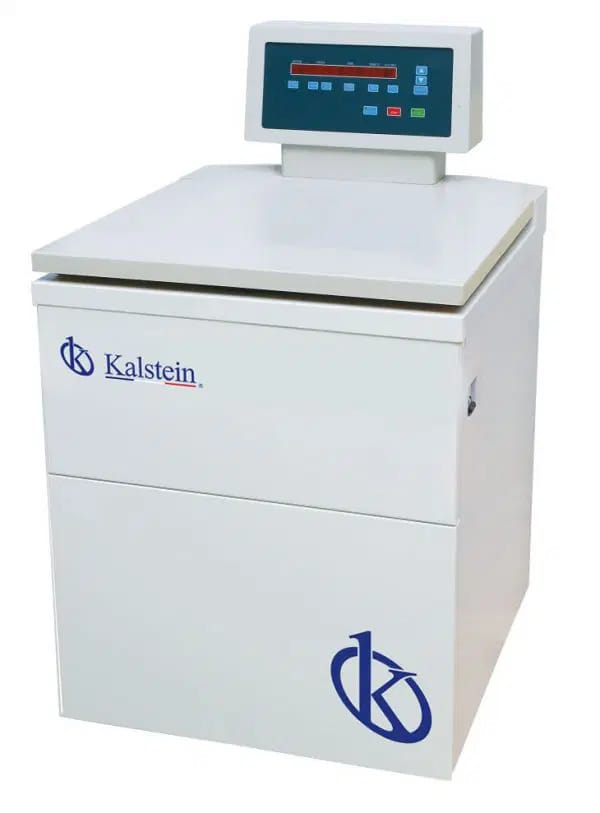
Refrigerated centrifuges
Within the broad category of centrifuges, refrigerated centrifuges stand out as a crucial tool in laboratory settings. These specialized centrifuges are equipped with cooling systems that maintain low temperatures during operation, ensuring the integrity of temperature-sensitive samples. By combining the centrifugal force with refrigeration capabilities, these centrifuges enable the separation, isolation, and analysis of biological substances with precision and efficiency. Whether in biomedical research, clinical diagnostics, or pharmaceutical development, refrigerated centrifuges play a fundamental role in various scientific disciplines.
The refrigerated centrifuges available at Kalstein provide advanced features such as precise temperature control, high-speed performance, and user-friendly interfaces. Designed to meet the diverse needs of modern laboratories, these centrifuges offer reliability and accuracy in sample processing. With a focus on quality and innovation, Kalstein’s refrigerated centrifuges empower researchers and scientists to achieve consistent and reproducible results in their experiments and analyses.
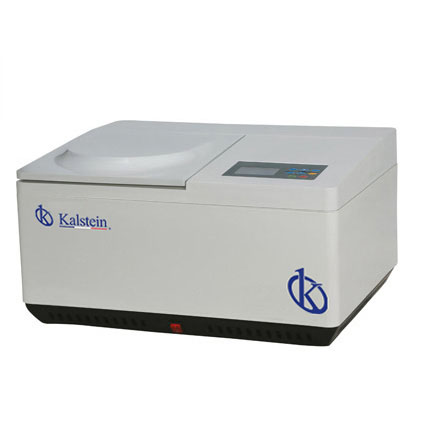
CENTRIFUGES KALSTEIN
At Kalstein you can find the ideal Centrifuges for Your Laboratory
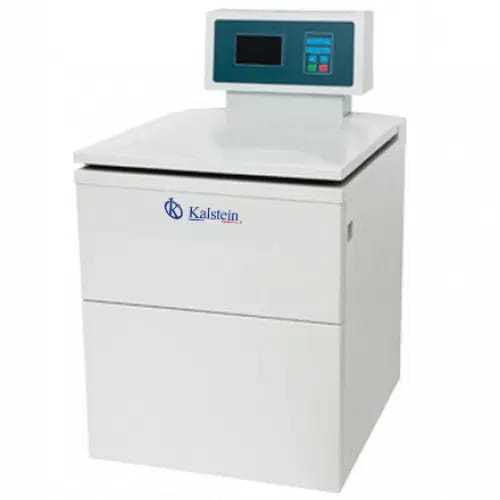
High-speed Refrigerated Centrifuge YR0114
The models are centrifuges used to collect micro-organisms and cell samples. The maximum RCF of these high-speed centrifuges is 52,000 g at a maximum speed of 22,0...

Gel Card Centrifuge YR142-3 – YR142-3-1
This machine is used for blood routine examination, gel card and immunodetection. It has micro-computer control, electronic lock and DC brushle...
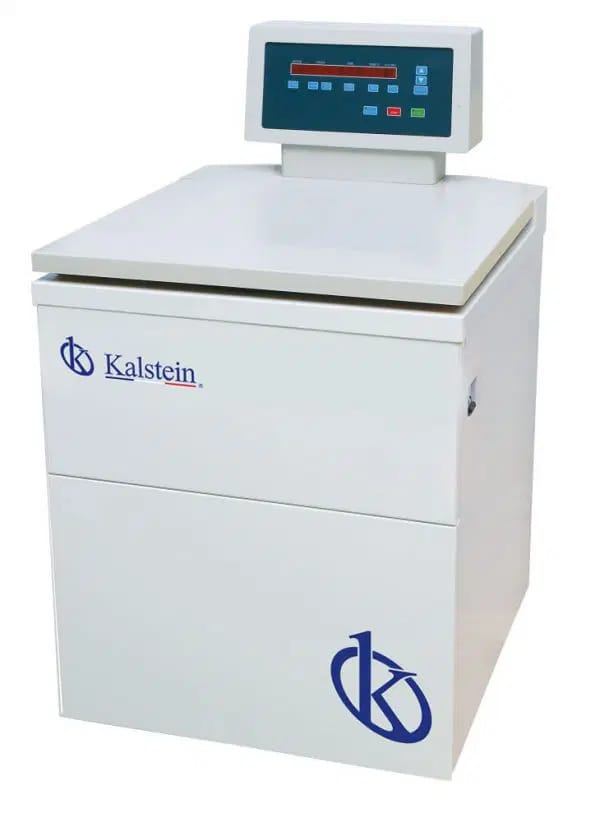
High-capacity Refrigerated Centrifuge YR118
Maximum capacity is 2400 ml x 6, i.e. 14400 ml. It features microcomputer control, electronic locking and a high-torque AC variable conversion motor. Compressor un...

High-capacity Refrigerated Centrifuge YR120
Maximum capacity is 2400 ml x 6, i.e. 14400 ml. It features microcomputer control, electronic locking and a high-torque AC variable conversion motor. Compressor un...
Our Centrifuge best seller
Maximum capacity is 2400 ml x 6, i.e. 1400 ml.
It features microcomputer control, electronic locking and a high-torque AC variable conversion motor.
CFC-free imported compressor unit. refrigerant. It complies with environmental standards.
The machine is programmable. Operation data can be stored automatically.
The LCD or LED display and touch panel make operation easy.
Real-time speed and RCF conversation are ideal for the operation.
It features a self-locking device, an overspeed safety device, an overtemperature safety device, an unbalance safety device and an automatic alarm device.
It has 10 acceleration and deceleration level files for you to choose from.
Sealed silastic comfort ring according to GMP. U.S. FDA-certified.
| Model | YR117-2 |
| Maximum speed | 8,000 rpm |
| FCR max | 11 260 g |
| Maximum capacity | 2,400 ml x g |
| Speed accuracy | ±50 rpm |
| Time parameters | 1min ~ 99h 59min |
| Temperature setting | -20 ~ +40°C |
| Heat exposure | ±1 °C |
| Compressor unit | French Tecumseh compressor unit, R404a |
| Power source | AC380V 50Hz 40A |
| Noise | ≤70dB(A) |
| Packaging size | 980x1100x1460mm |
| Weight | 500 kg |

Analysis of the best Centrifuges for Your Laboratory
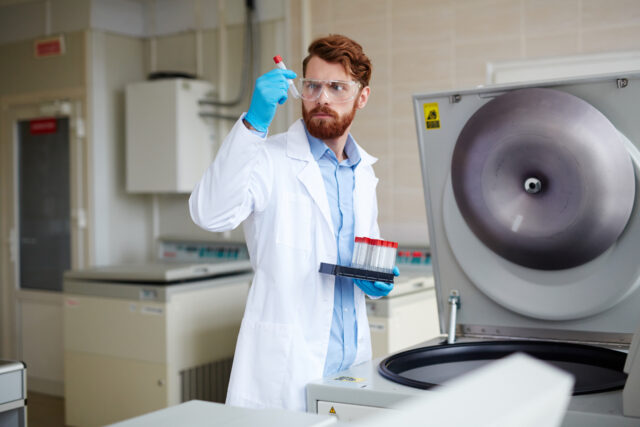
What are the Applications for High Speed Centrifuge and Low Speed Centrifuges?
Generally, centrifuges are equipment that form rotating movements, managing to separate elements in the samples for study...

What is Centrifuge used for in the Nuclear sector?
Centrifuge is used in the nuclear sector to isolate materials and remove contaminants. This application is one of the most common uses of centrifuges in the nuclear sector....

Centrifuge: When to use an angular rotor and a horizontal rotor?
This is an indispensable equipment for any laboratory, it is designed for material separation in the areas of molecular...
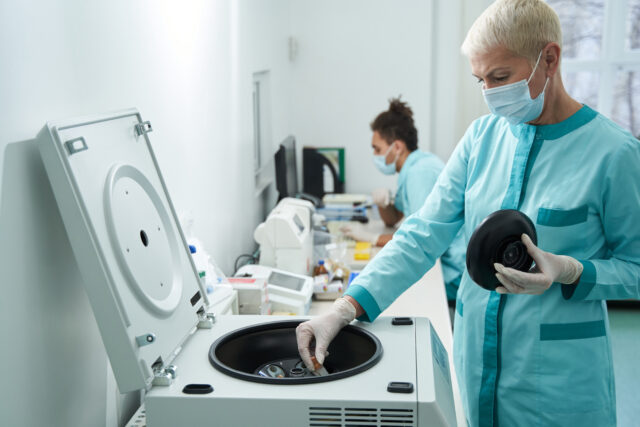
Centrifuge: How to separate samples?
Centrifugation is a process that is carried out in most laboratories and that allows the separation of mixtures made up of solid and liquid elements of different densities...
Catalog of models of Centrifuges on offer

Centrifuge PRP YR469-1 with LCD screen
Select options
Low speed table centrifuge YR0140-1
Select options
Speed table centrifuge YR134
Select options
Low speed centrifuge YR124-1
Select options
High-speed table centrifuge YR137-2
Select options
Centrifuge PRP YR469
Read more
Speed table centrifuge YR142-1
Select options
Speed table centrifuge YR131
Select options
KALSTEIN UPDATED
Guidelines for you to become an expert in Centrifuges
The Centrifuges equipment are essential products in Your Laboratory, we provide you with guidance and recommendations for a better use, so you can work like an expert.
How does a laboratory centrifuge work?
A centrifuge is a piece of equipment that separates particles from a homogeneous..
Use of Centrifuge for the production of Olive Oil
The centrifuge is a tool used in the production of olive oil to separate the oil from the pulp…
Laboratory centrifuges: care and maintenance
The care and maintenance of these laboratory equipment is indispensable to extend the…
Use of Centrifuge in Cosmetology
Cosmetology professionals have different types of tools that allow them to create high quality cosmetic products for their customers. Laboratory centrifuge is one such tool and is used to separate components of aqueous solutions…

Frequently asked questions from our customers about Centrifuges
To know the price of the centrifuges we invite you to send us an email with your request using the contact form. HERE
The delivery time of your Kalstein product will depend on the following:
- Whether the equipment you are interested in is in stock or if it needs to be manufactured.
- The type of freight you have chosen, which can be either air or sea.
- Equipment in stock:
– Delivery Time (Air): 15-30 days.
– Delivery Time (Sea): 45-60 days.
- Equipment not in stock:
– Delivery Time (Air): 30-60 days.
– Delivery Time (Sea): 60-90 days.
You can make your purchase through:
- By email: sales@kalstein.eu
- By phone: +33 (0) 1 70 39 26 50
- Online shopping: Through the official Kalstein website in your country.
All Kalstein equipment comes with a 1-year warranty against manufacturing defects. The warranty does not cover damages caused by improper installation or operation by the user, transportation defects, or uses other than those specified by the manufacturer. The warranty excludes electrical parts or consumables. For more information, visit our terms and conditions by clicking HERE.
At Kalstein, we provide our customers with inductions and technical support through new online methods. You can visit our induction videos, technical assistance, and guidance provided by a Kalstein team through our Youtube channel (Kalstein English). HERE
Certainly, you can request a quote for the Kalstein equipment you’re interested in, directly from our official website. Once you have identified the model of your preference, click HERE
Send us a direct message and one of our agents will contact you
Centrifuges
Lorem ipsum dolor sit amet, consectetur adipiscing elit. Sed dignissim placerat mauris cursus laoreet. Nam feugiat lacus ex, at fermentum sapien accumsan nec. Curabitur auctor porttitor mi non malesuada. Aenean condimentum, purus vitae rhoncus imperdiet, justo eros aliquam ipsum, at egestas leo diam eget libero.

Catalog of models of Centrifuges on offer.
-

Mini Centrifuge With Large Capacity YR012G
-

Tabletop High Speed Centrifuge YR0137-2 – YR0137-3
-

Gel Card Centrifuge YR142-3 – YR142-3-1
-

Tabletop High Speed Centrifuge YR019-TG
-

Electric Heating Drying Oven YR06446
-

Electric Heating Drying Oven YR05259-2
-

Electric heating drying oven YR05248 // YR05255
This product has multiple variants. The options may be chosen on the product page -

Electric heating drying oven YR05244 // YR05247
This product has multiple variants. The options may be chosen on the product page -

Intelligent Electric Wheelchair YR06432
-

Electric Wheelchair YR05445
-

Electric Wheelchair YR05443
-

Electric Wheelchair YR05442
-

Electric Wheelchair YR05444
-

Electric Wheelchair YR05441
-

Electric Wheelchair YR05440
-

Electric Wheelchair YR05439
Descubre más de nuestro catálogo
Tipos de Centrifuges

[Producto] A
Lorem ipsum dolor sit amet, consectetur adipiscing elit. Ut elit tellus, luctus nec ullamcorper mattis, pulvinar dapibus leo.

[Producto] B
Lorem ipsum dolor sit amet, consectetur adipiscing elit. Ut elit tellus, luctus nec ullamcorper mattis, pulvinar dapibus leo.
Find out more about Centrifuges with our guides.
Heating Mantles: Uniform Heating and Stirring in Laboratory Processes
In laboratories, achieving uniform heat distribution and constant stirring is essential to obtaining reliable and reproducible results. Heating mantles, designed...
Ultrasonic Cleaner: Deep Cleaning for Laboratory Instruments
In laboratories, cleaning instruments is an essential aspect to ensure accurate results and avoid cross-contamination. In my experience, using an...
Microplate Reader: Accurate Reading of Results in Biochemical Analyses
In research and biochemical analysis laboratories, precision is a crucial factor in ensuring the reliability of results. Microplate readers are...



